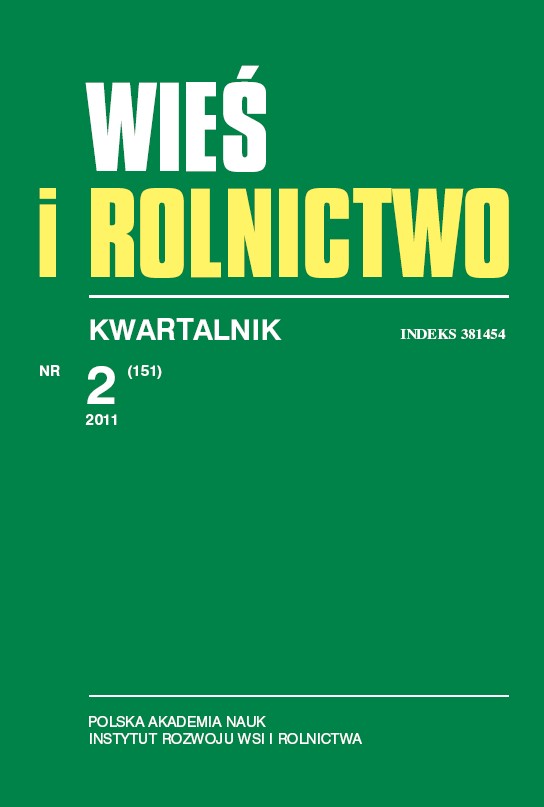The similarity of procreation behaviours in urban and rural areas of Poland in 1990-2009
DOI:
https://doi.org/10.53098/wir.2011.2.151/09Keywords:
procreation behaviours, rural areas, urban areasAbstract
Changes in procreation behaviours observable both in urban and rural areas since the early 1990s may result in the diminishing difference between these areas in terms of the intensity of fertility rate and the pattern of fertility. The aim of the article is to describe the changes that took place in 1990-2009 and to determine their direction and intensity. Additionally, the author of the article tries to identify these regions of Poland where the process of changes was the fastest and the occurring changes were similar.References
Adsera A., 2004: Changing fertility rates in developed countries. The impact of labour market institutions. „Journal of Population Economics” 17: 17–43.
Budnik A., Mrowicka B., Baran S., 2007: The fertility of women in Poland in the period of transformation of the political and economics system (the 80's and 90's). „Human Evolution” 18, 3–4: 243–250.
Chojnicki Z., 1996: Region w ujęciu geograficzno-systemowym. W: Podstawy regionalizacji geograficznej. Red. T. Czyż. Bogucki Wydawnictwo Naukowe, Poznań: 7–43.
Chromińska M., 1999: Uwarunkowania decyzji urodzenia kolejnego dziecka w rodzinie rolnika indywidualnego. „Studia Demograficzne” 1/135: 12–25.
Czyż T., 2002: Zastosowanie modelu potencjału w analizie zróżnicowania regionalnego Polski. „Studia Regionalne i Lokalne” 2–3: 5–14.
Florczak W., 2008: Makroekonomiczne uwarunkowania płodności w Polsce: próba kwantyfikacji. „Studia Demograficzne” 1–2/153–154: 82–111.
Frątczak E., Liefbroer A., 1996: The Family Formation Process in Poland During the Early Years of Economic Transition: Evidence from Polish Family and Fertility Survey 1991. „Studia Demograficzne” 1–2: 39–53.
Frątczak E., Ptak-Chmielewska A., 1999: Formuła Bongaartsa-Feeneya – zastosowania dla Polski. „Studia Demograficzne” 2/136: 43–61.
Gołata E., 1995: Płodność i małżeńskość w Polsce w okresie transformacji społeczno-gospodarczej. „Studia Demograficzne” 3/121: 91–103.
Kocot-Górecka K., 2002: Aktywność ekonomiczna kobiet a zmiany wzorca płodności w Polsce. Praca doktorska. ISiD, KAE, SGH, Warszawa.
Kotowska I.E., 2002: Zmiany modelu rodziny. Polska – kraje europejskie. „Polityka Społeczna” 4:13–17.
Kotowska I.E., Jóźwiak J., Matysiak A., Baranowska A., 2008: Poland: Fertility decline as a response to profund societal and labour market changes? „Demographic Research” 19:795–854.
Kurkiewicz J., 1998: Modele przemian płodności w wybranych krajach europejskich w świetle drugiego przejścia demograficznego. „Zeszyty Naukowe Akademii Ekonomicznej w Krakowie” 131: 28–54.
Malina A., 2006: Analiza zmian struktury zatrudnienia w Polsce w porównaniu z krajami Unii Europejskiej. Zeszyty Naukowe Akademii Ekonomicznej w Krakowie 726, Wydawnictwo AE, Kraków.
Matysiak A., 2005: The sharing of professional and household duties between Polish couples: preferences and actual choices. „Studia Demograficzne” 1: 122–153.
Mishtal J.Z., 2009: Understanding low fertility in Poland. Demographic consequences of gendered discrimination in employment and post-socialist neoliberal restructuring. „Demographic Research” 21: 597–626.
Młodak A., 2006: Analiza taksonomiczna w statystyce regionalnej. Difin, Warszawa.
Mynarska M., 2009: Individual fertility choices in Poland. Universität Rostock, Rostock.
Nowińska-Łaźniewska E., Górecki T., 2005: Metody badań przestrzenno-ekonomicznych w ujęciu dynamicznym i ich zastosowanie w regionalistyce. „Studia Regionalne i Lokalne” 2: 89–100.
Roczniki Demograficzne z lat 1991–2010. GUS, Warszawa.
Szuman A., 1998: Postawy i zachowania prokreacyjne matek pracujących zawodowo w warunkach przekształceń systemowych w Polsce. „Studia Demograficzne” 3/133: 37–60.
Toński P., 1999: Przestrzenne zróżnicowanie płodności w Polsce w latach 1989–1997. „Studia Demograficzne” 1/135: 23–41.
Downloads
Article file downloads
Pages
How to Cite
Issue
Section
License
Copyright (c) 2011 Wieś i Rolnictwo

This work is licensed under a Creative Commons Attribution 4.0 International License.










